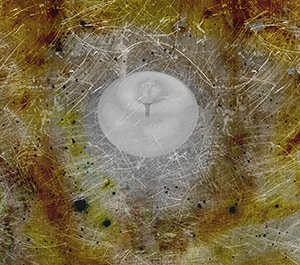Scientific magazine Ultrasonics Sonochemistry published a special edition on the topic ‘Cleaning with bubbles’. We are proud to have been Guest Editor for this special issue, which can now be found online at: http://www.sciencedirect.com/science/journal/13504177/29.

Artist impression of a cleaning bubble.
Image by Leon Assink.
We have asked several renowned scientists with different expertises to answer the question on how bubbles exactly can clean: is it the jets or shockwaves that they produce, or because of the generated radicals?
The short answer is that the different effects are important for different applications. Both jets and shockwaves may play a role in removing particulate and film contamination. Their relative contribution depends on the local circumstances, including bubble stand-off distance, pressure conditions, and material properties. Radicals may play a role in removing microbial or chemical species; however their relative contribution is application-dependent.
For the various applications of ultrasonic cleaning, it means that it is important to have thorough knowledge of the different phenomena that occur during cavitation, in order to optimally put the bubbles to use.
Read also: “Article on ‘Measuring cavitation and its cleaning effect’ in ULTSON”, which is part of this Special Issue.



